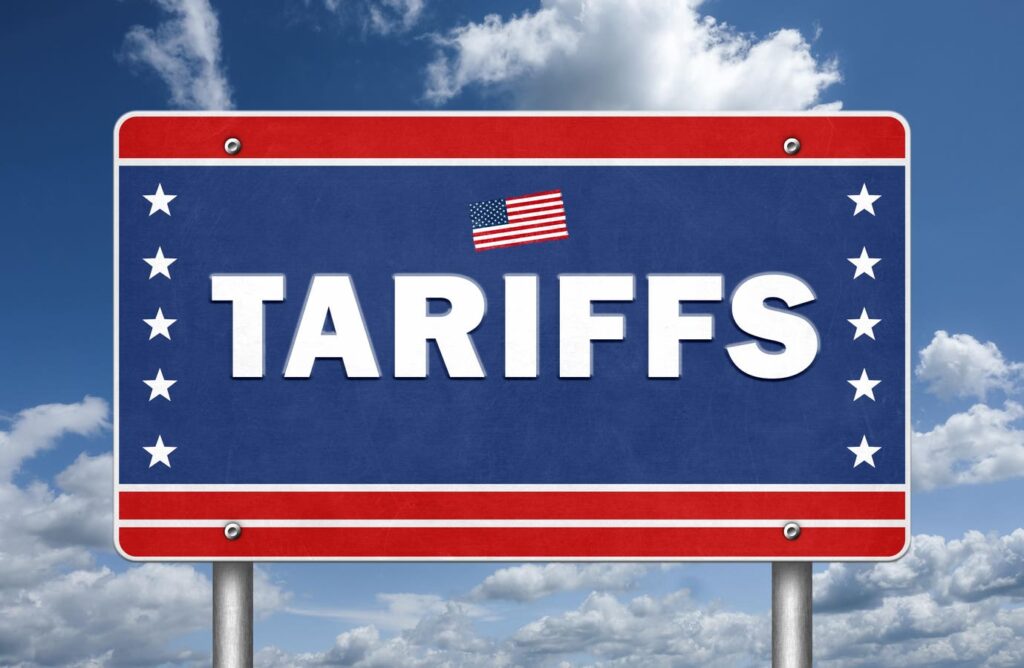By Rieva Lesonsky
Pennsylvania Governor Josh Shapiro recently said, “Small businesses are facing strong headwinds right now because of the decisions made by the federal government to impose these tariffs.” This point was underscored by the small business owners we talked to, who are impacted by the tariff turbulence.
To successfully navigate this storm, don’t go it alone. A small business owner I interviewed said, “We need help surviving this nightmare.” Luckily, assistance is available. Eric Groves, co-founder of Alignable, says his 9 million members are turning to one another “to problem-solve in the network because they realize you can solve problems faster and better together.”
Hopefully, you have a strong network you can rely on. Don’t overlook your accountant, lawyer, or banker. Talk to your suppliers to find out what they think. Sunscape Eyewear president Adam Rizza says his Chinese suppliers told him they would “stay strong and not fold” because they believe “they can ride this out.”
It’s akin to being on a roller coaster. Groves says, “While recent developments—like the UK trade deal or the temporary rollback of the U.S.-China tariffs—offer some hope, they don’t resolve the underlying uncertainty.
Business owners still don’t know what their cost structures will look like next quarter, let alone next year. That makes it nearly impossible to plan, price, or invest confidently.”
To learn more, I interviewed small business service providers, experts, and advocates about their perspectives and advice on the tariff crisis.
Insight and Advice About Tariffs
How Will Tariff Turbulence Impact Small Business Owners?
Ben Johnston, chief operating officer, Kapitus: Tariffs on foreign goods could, over time, make manufacturing in the U.S. more economic relative to importing goods from abroad. But in the short to medium term, tariffs will likely drive inflation higher and significantly disrupt the global supply chain, threatening many U.S. jobs at manufacturers, wholesalers, and retailers. These industries rely heavily on global suppliers to source the components, raw materials, and finished products they sell.
Higher tariffs will certainly raise consumer prices, as tariffs drive up the cost of imported products, which must be passed on to the customer. This will spur inflation, lower overall consumption, and slow the economy. However, in the long run, higher tariffs may help protect the viability of certain U.S. manufacturers and could incent greater investment in U.S. manufacturing.
Karen Kerrigan, president and CEO, Small Business & Entrepreneurship Council: In the short term, uncertainty is lowering confidence and restraining investment and hiring for most small business owners, who were already dealing with elevated costs and ambiguity about tax relief measures that are set to expire at the end of 2025. Therefore, the tariff tumult is only adding to pressures and uncertainty about future costs, the effect on supply chains, and trying to figure out how this will impact revenues for the year.
There seems to be some positive news for the mid to long term. Both the White House and many of our trading partners are already working toward a resolution via talks on trade “deals.” I believe over the next month or sooner, we’ll see the contours of what these deals will look like, which will lower tariffs and hopefully open markets on a reciprocal basis. Still, trade deals take some time as they involve a lot of details. Hopefully, these interim agreements will be designed with certainty in mind for businesses and consumers.
The big outlier is China, which will be the most challenging trade “deal” to resolve, and U.S.-China tensions will probably ebb and flow over a longer period.
Jake Cohen, head of industry and insights, Klaviyo: Businesses are being asked to do more with less while trying to make sense of real-time shifting consumer behavior. In the short term, small business owners must reevaluate their pricing and suppliers and deal with potential supply chain disruption, all while trying to survive and keep customers happy.
Consumers are first turning to brands they trust and looking for guidance. To drive loyalty, be transparent. Share context around pricing and supply chain challenges. A recent Klaviyo survey found that 28% of shoppers stick with brands they already love, and 62% want clarity around pricing.
Itzik Levy, CEO and founder, vcita: The new policies will impact SMBs directly and indirectly. One immediate concern is the impact of rising costs on their cash flow. Since many small businesses operate on tight margins, they cannot easily absorb additional costs. The requirement to pay tariffs on goods upon arrival, while suppliers often offer 90-day payment terms, exacerbates cash flow issues.
Many SMBs face a dilemma: Do they continue investing in business growth as planned, despite the economic uncertainty? The abrupt implementation of tariffs has created a climate where plans must be reexamined and reevaluated. SBOs are hesitant to make investments due to the unpredictable economic environment.
SMBs’ shift toward more conservative spending will impact service providers who cater to this market. As SMBs reevaluate their expenses and cut back where they can, vendors must provide clear-cut, impactful, and irreplaceable value. Organizations that serve the SMB market must be prepared to showcase their services and prove to their customers that what they are paying for has a high ROI.
Aditya Narula, SVP and general manager of lending and credit, Bluevine: Short term: the pressure is real. When tariffs hit, every dollar matters. Small businesses need to know how much impact they can absorb, where tariffs will hit, and strategize how to plan their future to minimize those impacts.
If you don’t have a line of credit now, it’s worth considering. A good line of credit can be a lifeline when things get lean. Securing it before you need it gives you breathing room if tariffs start stinging or payments slow down.
In the long run, tariffs could improve lending conditions. But the short-term pressure is real—on margins, supply chains, and credit. When costs spike, lenders pay closer attention to how stable a business really is.
Brian Moran, small business expert and CEO, Small Business Edge: In the short term, if all the tariffs go through, even at 10%, margins will tighten, and cash flow could take a hit. Long term, increased tariffs may push more small businesses to diversify sourcing and build stronger domestic supplier networks, which will be as expensive, if not pricier, than working with foreign partners. The demand for local sources will drive prices up.
More from AllBusiness:
Tips to Help Small Businesses Navigate Rising Tariffs
Sharon Miller, president of business banking, Bank of America: Business owners today must stay updated on the rapidly changing macroeconomic environment and maintain a strategic outlook, keeping their long-term goals and the core purpose of their businesses in sight. Staying grounded in their business mission helps foster a sense of resiliency and will steer their business through uncertain times.
Practical tips business owners can realistically put into practice:
- Streamline your costs and improve revenue to maintain margins. Monitor the financial performance of your business and regularly reevaluate your business plan. Keeping tight control over internal and external costs ensures your business maintains its margins and helps you weather the storm.
- Attract and retain talent. Your employees are one of your greatest assets and are essential to business operations. During economic uncertainty, ensure your workplace culture and employee morale are supported, acknowledged, and clearly communicated, and regularly communicate your company’s values and priorities.
- Forge customer connections. Your business depends upon a reliable, loyal, and devoted customer base. Create personalized experiences to build stronger relationships that enhance brand loyalty. This will also help your business improve products and services while establishing a deeper level of trust and transparency with your customer base and community.
- Streamline, invest in, and modernize your business. It’s easy to delay or cancel large expenditures you planned for your business’s technology and/or operations during uncertain economic times. However, it’s best to look at these as investments for your company’s future that will ultimately help you grow and expand during more stable and prosperous periods.
Frank Vella, CEO, Constant Contact: Marketing is one of small businesses’ most powerful tools for building resilience. Maintaining consistent communication with customers keeps them engaged and communicates your value. This ensures that when it comes time to buy, they already know how to support you.
Actively explore the resources in your local communities. Engaging with local chambers of commerce, industry and trade groups, and peer networks provides learning, connection, and growth opportunities.
Sarah Acton, chief customer officer, BILL: Cash flow is critical, especially at times like this. When you have a clear picture of your financial position, you’re better equipped to respond strategically and manage new opportunities. Technology is key—automation helps you be more efficient and enables you to make informed strategic decisions based on real-time data.
Advanced technology and tools once reserved for enterprise companies are now helping SMBs act faster, scale smarter, and confidently navigate complexity. In BILL’s recent survey, 73% of SMBs said AI already impacts their businesses, and 83% expected it to play a greater role over the next two years.
The time is now to invest in technology that equips you with the tools and data to make smart, informed decisions and build resilient financial strategies. That’s the opportunity in front of all of us.
Ben Johnston: If you import goods from abroad, can you source these goods domestically or vertically integrate your supply chains to produce them domestically? If this proves uneconomical, see where the tariffs are levied and which countries are most impacted. Some importers benefit from quickly relocating production from one country to another, as countries like China face stiffer tariffs than neighboring nations with similar production capabilities.
Beyond tariffs:
- Be judicious in your expansion plans. In uncertain economic times, focus on the goods and services that demonstrate customer value. Before launching a new product or opening a new facility, thoroughly test the market to determine demand and pricing power. Make sure anticipated sales will more than cover anticipated expenses, and be sure you have sufficient capital to cover several months of operating expenses in case sales take longer to materialize.
- If you borrow money to purchase inventory, acquire equipment, and fund expansion, it’s important to maintain multiple financing relationships. Banks have pulled back from lending to small businesses over the past several years, and having contacts at both bank and non-bank lending institutions can help secure the fastest and lowest-cost capital.
- Investing in new technologies and business processes, such as software that better manages inventory or helps customers self-serve, saves time and may allow you to operate longer with fewer staff.
Itzik Levy: Turbulent times can be daunting for small business owners, but they can also spark innovation and resilience. SMBs should focus on controlling what they can control. They can’t change tariffs, but they can build a business that is agile, lean, and ready to adapt.
- Start by embracing digital tools. Digitizing operations isn’t a luxury anymore; it’s essential. From scheduling to billing to client communication, there are platforms that allow you to do more with less while delivering a better customer experience.
- Don’t underestimate the power of AI. It can help you write better marketing copy, respond faster to leads, and predict financial patterns, without hiring a team of data scientists.
- Consolidate. Using different tools that don’t talk to each other wastes time and money. Find platforms that offer an all-in-one approach to get a clearer view of your operations.
- Know your numbers. Use technology to gain full visibility into your finances. Know what is bringing money in and where you are spending the most. A 360 view of your finances helps you make smarter decisions, prioritize the right activities, and avoid being caught off guard. In times like these, that kind of clarity is priceless.
Greg Strickland, CEO, Ignition: Professional service prices are already climbing. It’s not just the broader impact of tariffs or the concerns about inflation. Many businesses, including accounting firms, consultants, and marketing agencies, have kept fees low post-pandemic in fear of losing clients. They are feeling the squeeze now with costs rising and undervalued pricing.
Ignition’s recent pricing survey found that over 50% of accounting firms plan to raise fees in 2025. Many small businesses are likely to follow suit, but the smartest businesses don’t just raise prices—they rethink them. We will see a shift to transparent, value-driven pricing models that align with customer needs and perceptions.
Small businesses should evaluate whether their prices reflect their value. Bundling services or tiered pricing could unlock untapped revenue without losing client trust. Too often, businesses hesitate to raise prices because the process is manual, time-consuming, and uncomfortable. This results in shrinking profit margins and stalled growth—a vicious cycle. This is about survival, and small businesses need to think of pricing as a growth engine, not a roadblock.
Jake Cohen: In times of uncertainty, the brands that succeed genuinely understand their customers. Klaviyo’s recent survey shows consumers aren’t cutting back yet, but they’re signaling caution. Now is the time to deprioritize customer acquisition and instead double down on platforms that enhance customer retention.
Larry Neilson, CEO and co-founder, Neilson Marketing Services and ProgramBusiness.com: If the tariffs stick around, higher costs will eventually impact insurance coverage and claims. Materials and replacement costs rise, affecting underwriting and loss ratios. However, it may not materialize into a big issue depending on when and how trade deals are struck. It’s hard to plan around uncertainty, but that’s the world we’re in.
We always encourage our clients to keep their foot on the gas. In tough times, going quiet is the worst move. Whether it’s email, telemarketing, SEO, or just good data-driven targeting, staying visible and in motion is how small businesses survive and grow.
Aditya Narula: Start with the basics. Don’t wait until you’re in a pinch to develop a contingency plan. Know your burn rate and examine working capital with a magnifying glass. This will give you breathing room to be thoughtful instead of reactive when the next curveball hits.
Matt Kolb, managing partner, DataShopper: If these tariffs drag on, we’ll see major layoffs and a credit crunch, especially for small businesses. Proactively fill your pipeline and expand outreach. The survival plan for any business right now should include checking in with every customer and firing up your team, especially marketing and sales, to drive revenue and retention.
Brian Moran: Keep a close eye on your cash flow, raise prices gradually if needed, and don’t hesitate to ask suppliers for better terms. Look for opportunities in the chaos—there are always a few left by competitors who pulled back too quickly. Talk to other business owners, stay updated on trade news, and create a “what if” plan for your top three risks. The businesses that adapt the fastest usually come out stronger.
Can Resilience Crush Tariff Troubles?
Small business owners are worried, comparing this tariff crisis to the disruption Covid brought to their businesses. But like Karen Kerrigan, I am a radical optimist and believe small businesses will prevail. Why? Because, as vcita’s Itzik Levy says, “SMBs are far more resilient than they are often given credit for.”
Read the full article here











